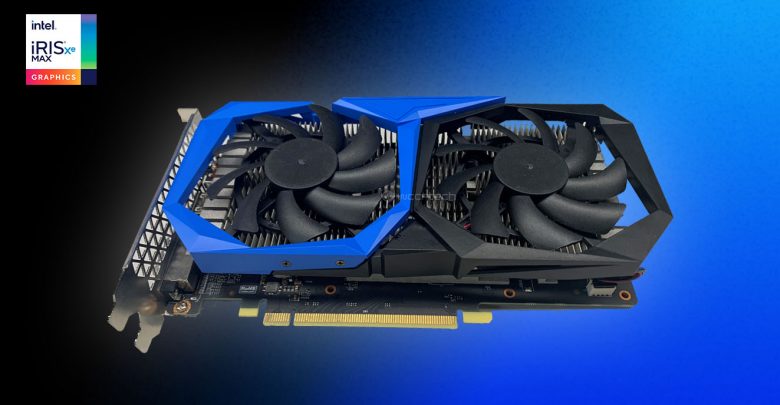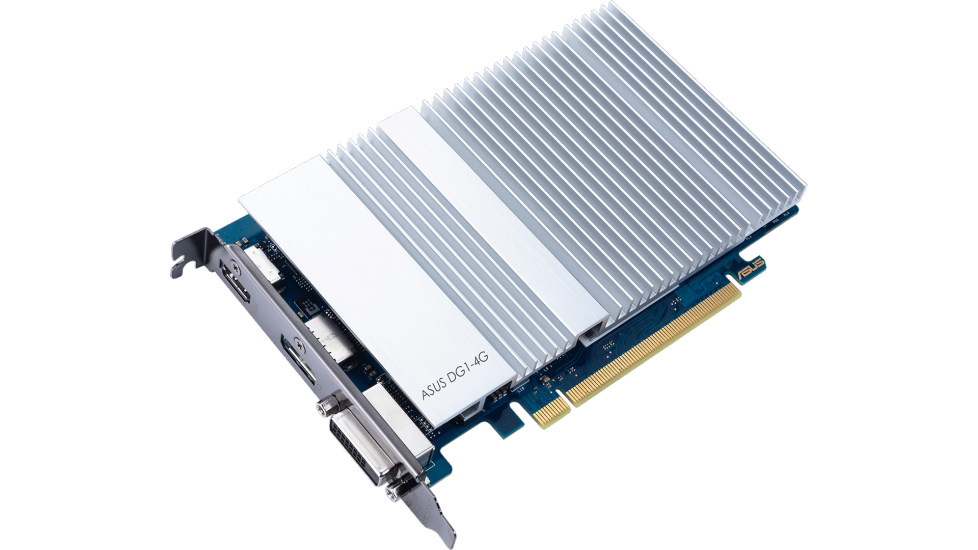
A dream that started well over a few years ago, when the RTG (Radeon Technologies Group) head Raja Koduri joined Intel. This has borne its first fruit: the OEM-only Intel DG1 Xe Graphics Card. While the DG1 might not be the most powerful card around, it is absolutely critical as a proof of concept and necessary for Intel to get the hang of things before it jumps into the GPU market with full force. From the looks of it, the GPU may be as powerful as a intel’s iGPUs on their latest CPU architecture. As of now, partnering with OEMs means these Intel DG1 Graphics Cards will be made available on pre-built systems only. So far, two variants of the DG1 have been at least partially announced—an Asus-branded, passively cooled card and an actively cooled version from an unannounced vendor.
Intel DG1 features and specifications:
The Intel Iris Xe features DG1 GPU based on its new 10nm SuperFin architecture. The Iris Xe discrete graphics card features 80EUs (or 640 ALUs), 40 Texture units, and probably 20 ROPs if the ratio from Tiger Lake remains the same. The Xe dGPU is actually a cut-down variant featuring 16 fewer EUs than its mobile counterpart meaning this is likely a lower binned variant of the same wafer start.

This is actually a very good strategy because that means Intel will be able to ship a lot more of these as the salvaged chips from DG1 will not be wasted and instead put to use in dGPUs likely sold for cheap to its partners.
While they’re not revealing the clock speed for the non-Max variant, the Iris Xe MAX is reported to be clocked at 1650 to 1700MHz which will mean that it can offer a graphics horsepower of 2.17 TFLOPs – which is more than the original PS4. The TDP is going to be 30 Watts (which is peanuts for a discrete card and why ASUS can get away with a fan less design) and it will be manufactured on Intel’s 10nm SuperFin technology. Considering its 5W more power-hungry than the mobility card, we can safely assume its clock speed will be higher than 1700 MHz.

If you’re hoping to score a gray-market DG1 and include it in a home-built system of your own, you’re out of luck. Intel told LegitReviews that DG1 cards will work only on very specific systems, with custom UEFI (BIOS) that supports the card:
The Iris Xe discrete add-in card will be paired with 9th gen (Coffee Lake-S) and 10th gen (Comet Lake-S) Intel® Core™ desktop processors and Intel(R) B460, H410, B365, and H310C chipset-based motherboards and sold as part of pre-built systems. These motherboards require a special BIOS that supports Intel Iris Xe, so the cards won’t be compatible with other systems.
For pre-built systems, the Intel Xe DG1 Graphics Card makes sense as already we know Intel can deliver decent graphics performance with its Xe Max graphics for laptops. Essentially, this is almost the same laptop GPU, featuring on upcoming desktops as well as serving a trail run for Intel.
The architecture is, of course, Xe-LP and it features 4GB of vRAM. While we are not sure of the quantity and when and if gamers will be able to get their hands (through OEM prebuilt) on this, it reaffirms Intel’s ambition to see itself as the third player in the highly lucrative GPU business. The DG series is Intel’s way of beta testing their platform and priming their partners and channels for the main show – which will not happen till 2022. Intel is also poised to release an HPG based graphics card that will be targeted at gamers and should be rock bottom priced as well.
Intel DG1 performance:
With a Fire Strike of 5,538, the Intel DG1 dev card from that May leak is faster than onboard graphics—but it’s slower than entry-level discrete GPUs from AMD (RX 560) and Nvidia (GTX 1050), and it isn’t even close to being on par with higher-end gaming GPUs. Of course, those leaked benchmarks were on a development version of the DG1, and it’s possible that the newly launched OEM version will be faster—but we don’t actually expect that to be the case.
The OEM version might even be slower in hardware than the dev version was—the new OEM versions offer 80 Execution Units (EUs), while at least some versions of the dev cards sported 96. Improvements in driver quality over the last eight months are more likely to make a positive impact on performance, but we doubt it will change the card’s ultimate place in the market—the DG2 may be a different story entirely, but DG1 seems fated to drive relatively cheap desktops without heavy gaming focus.
The full press release is given below:
Intel codesigned and partnered with two ecosystem partners, including ASUS, to launch the Intel® Iris® Xe discrete desktop graphics cards (code-named “DG1”) in systems targeted to mainstream users and small- and medium-size businesses. The cards are sold to system integrators who will offer Iris Xe discrete graphics as part of pre-built systems.
Following the launch of Intel® Iris® Xe MAX for notebooks, Intel’s first Xe-based discrete graphics processing unit, Intel and its partners saw the opportunity to better serve the high-volume, value-desktop market with improved graphics, display and media acceleration capabilities.
The new cards offer a compelling upgrade to existing options in the market segment. They feature three display outputs; hardware video decode and encode acceleration, including AV1 decode support; Adaptive Sync; Display HDR support and artificial intelligence capabilities thanks to DP4a deep-learning inference acceleration. The Iris Xe discrete graphics cards come with 80 execution units and 4 gigabytes of video memory.
We expect to see the DG1 cards show up in OEMs’ value-oriented desktop lineup later in 2021.




